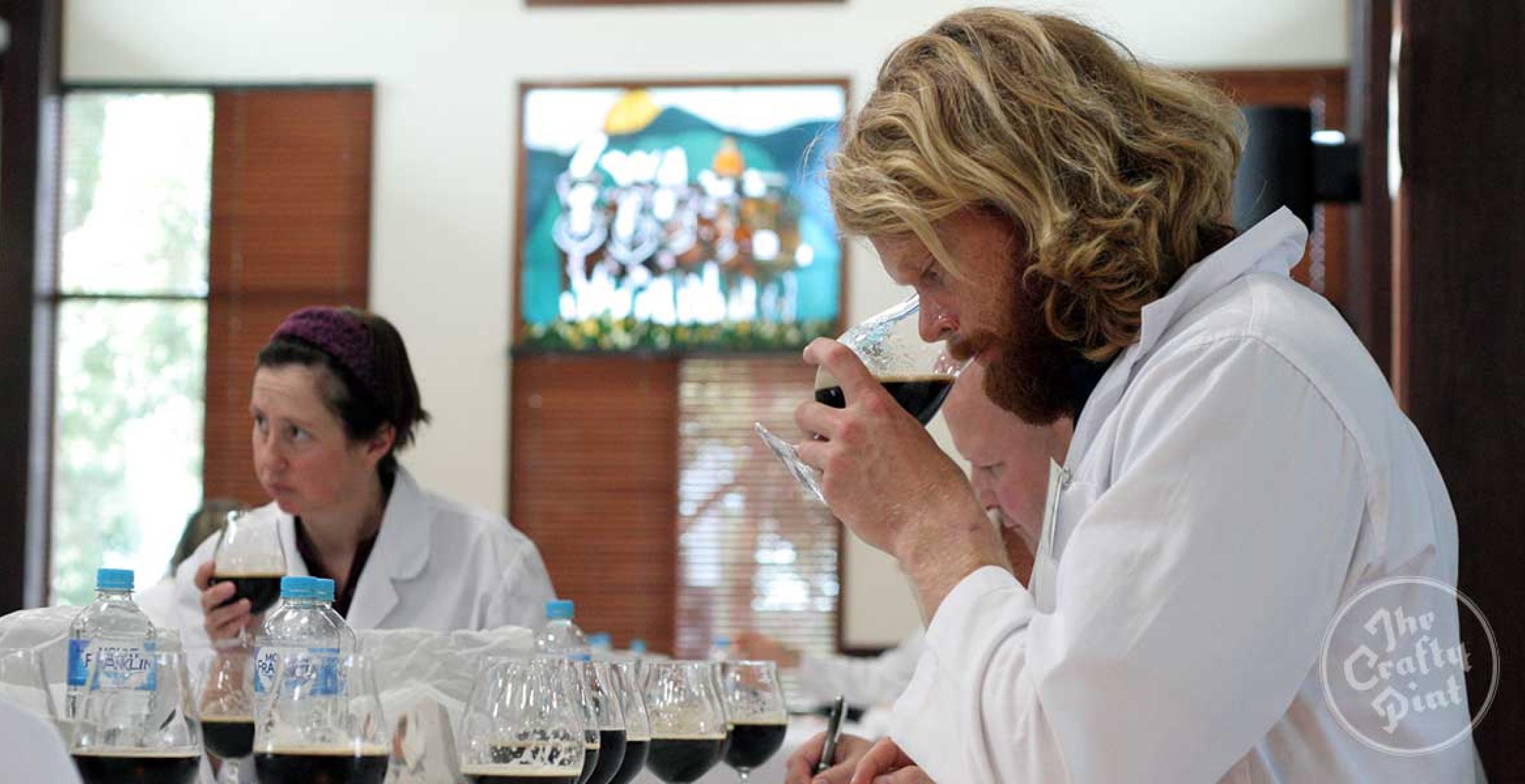Next month, brewers and beer experts from across the globe will make their way to Melbourne to take part in the Australian International Beer Awards judging for 2017. It's the second largest beer awards of its kind in the world and leads into one of the biggest celebrations of good beer anywhere in the world too.
Judging finishes on the day Good Beer Week starts, with the awards handed out on May 19 – the day before GABS Melbourne kicks off. But what goes into the judging of beers, good or bad? How do you get involved in such a magnificent sounding endeavour?
Nick Oscilowski spent time with the brewers and stewards at the last Sydney Royal Beer and Cider Show to find out more...
If someone said to you, with sincerity, that they’d had a tough day when the entirety of it was spent drinking beer, how much genuine sympathy do you think you could muster? "None" would seem a pretty reasonable first response, though if that person was a beer judge you might be able to soften your view ever so slightly.
To be sure, beer judging is never going to match, say, the physical demands of being down t'pit or the emotional burden of working in a hospice, but it does require its own set of special skills. To be able to do it with any degree of respectability requires, as a minimum, formidable knowledge, an ability to apply intense levels of concentration and critical evaluation for a full day or more, plus the determination to mount a stubborn and prolonged resistance to the effects of inebriation.
The purpose of this toil? Medals and glory.
Sticking a gold medal on a beer can have a transformative effect: its brewer gets to feel the warm glow of the limelight, the brewery where it was made might become a must visit destination, and the beer itself can go from unknown or forgotten to in demand and out-of-stock almost overnight.
But how do the rigours of judging transfer through to medals? What makes a beer worthy of a gold, as opposed to a silver? Why might a beer you love dearly not make an impression a beer judge? And why should you trust the judges’ judgement in the first place?
For the latest in our A Day In The Life Of… series, we shed some light on the many mysteries behind beer awards, pulling up the curtain and going behind the scenes with stewards at the Sydney Royal Beer and Cider Show before getting inside the head of one of its judges.
NB Scroll down for the interview with a judge. First comes the ins and outs of how these competitions are run.
The Cast
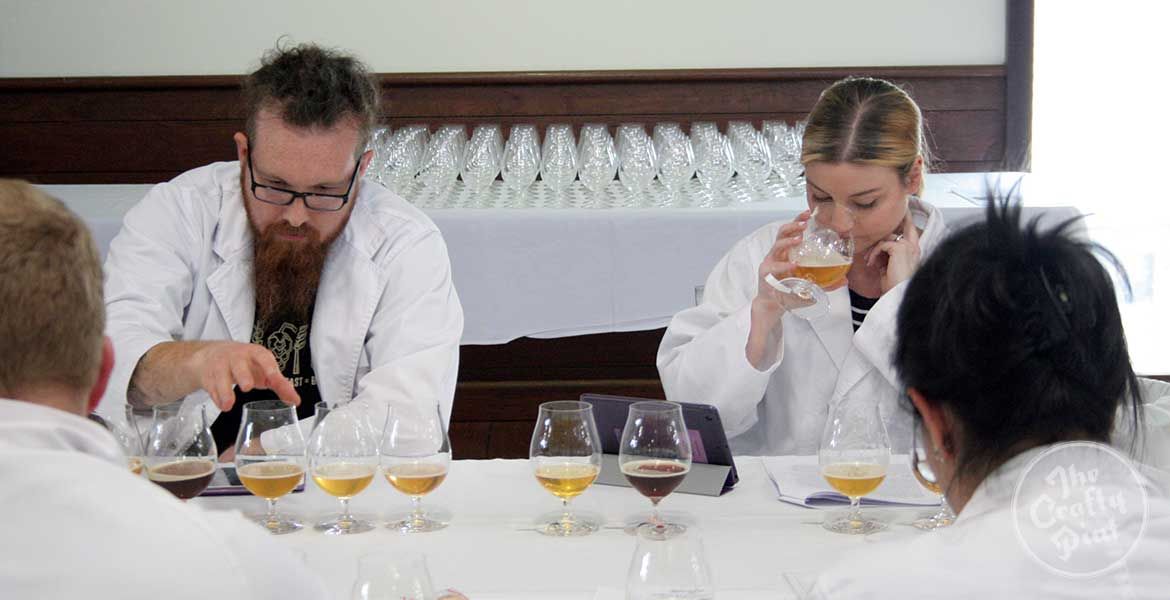
Chair of Judges
As the captain of the team, a good chunk of the Chair of Judges’ work is preparation done prior to the competition. They help select the team of judges and work with the show’s organisers to ensure every beer entry is classified correctly so that when the judges arrive on the day they can more or less just sit down and get on with the job. Come competition time, the Chair of Judges actually tastes very few beers. On the day, their role is more of a manager, ensuring everything runs smoothly and being a designated font of knowledge. For example, if a panel of judges believes a beer to be faulty or incorrectly classified, the Chair of Judges will be the arbitrator.
Judges
Your typical beer competition will have judges from many backgrounds: brewers from the corporate-owned breweries; brewers from small independent breweries; brewers from a big brewery background but now working at a small brewery; sensory and lab technicians; buyers from national retail chains. In short, a lot of people whose business it is to be critical of beer in many forms and at many points along the chain.
Associate Judges
In addition to judges, some tables also have an associate judge. This is effectively a judging apprenticeship for someone earmarked as having the knowledge to be a beer judge but who has not yet accumulated sufficient experience under competitive conditions. Associate judges taste, rate and comment on beers in the same way as any other judge, but their final score does not contribute to the competition results.
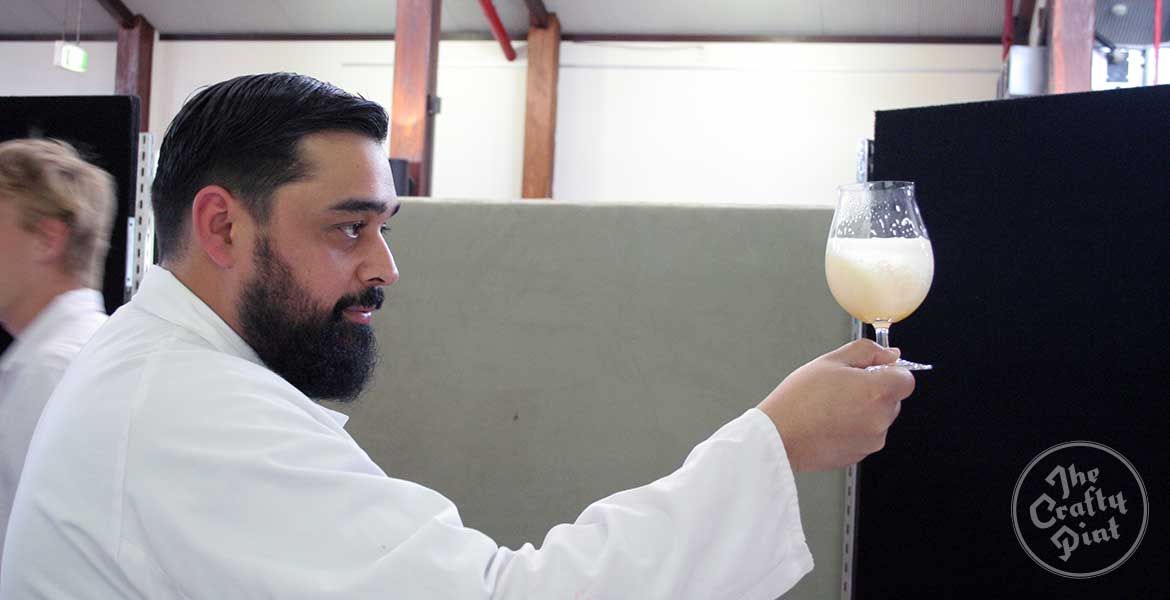
Stewards
Pour the beer, take it to the table. That’s the steward’s lot and if it all sounds rather simple, it is – in principle. But when you consider that there are hundreds upon hundreds of entries, all being delivered at different times to different tables while stripped of all familiar branding, one mistake and the show can turn to shit with one poor pour.
In an attempt to circumvent this, the Sydney Royal recruits what you might call "beer people" – at the last show, this included two from a beer tour and events operator, a brewing company owner and sales rep, a beer writer and a qualified Cicerone – with the idea being that having people with a sound level of knowledge behind the scenes will help things run smoothly. In return, the stewards, who are all volunteers, get opportunities throughout the day to join tables in an associate judge's position, partake of a generally interesting experience, and have the odd sip of the leftovers at the end of the day.
Chief Steward
Traffic controller meets quality controller meets logistics manager with a touch of omnipresence, the Chief Steward is the main person standing between a successful day and a total shambles. They’re charged with ensuring the stewards correctly label and deliver the right classes of beer to the right judges, in the right order, at the right time, at the right temperature, with any special needs met – for example, making sure certain beers are roused (think of the classic “Cooper’s roll” to disturb the yeast). Such a minor detail may seem trivial but if that beer doesn’t get roused when it should have been, it might get marked down for its appearance which drops its score, which means it doesn’t get a gold medal – or perhaps any medal – and the brewer doesn't get to bask in any glory or experience a spike in sales. And all because someone didn't roll a bottle before they poured a beer. Thus the Chief Steward has to be switched on, all the time.
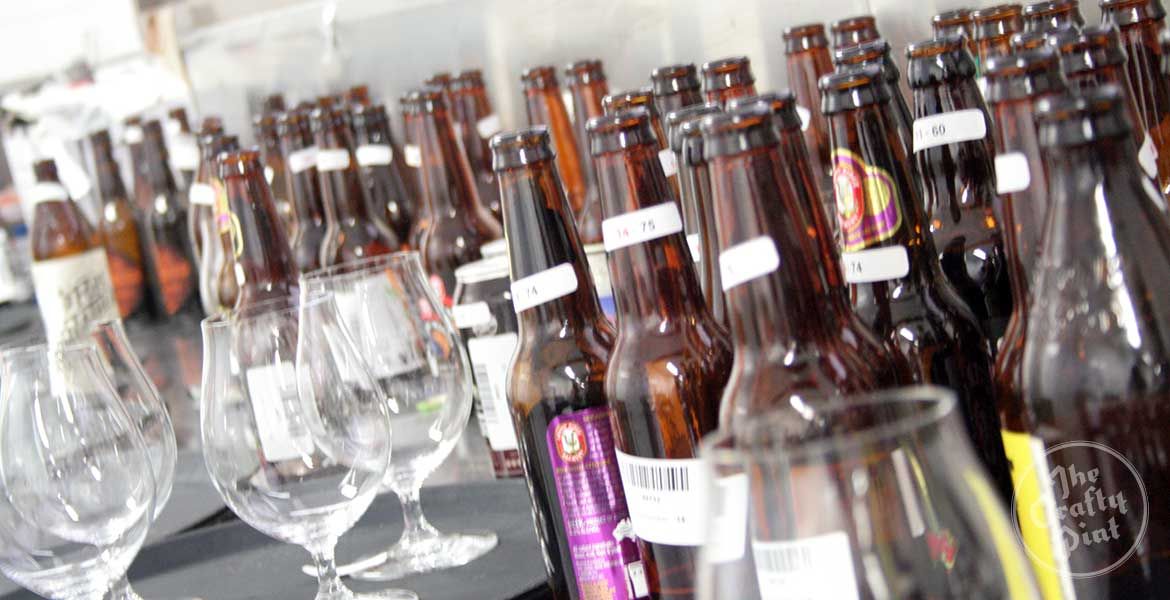
On With The Show...
Sensory Workout
Around 8am, before many office workers will have consumed their first coffee of the morning, a flock of white-coated judges is facing up to a round of beers laced with contaminants. This is a deliberate early morning sensory workout whereby a set of capsules is dropped into perfectly good beers in order to taint them in some way: acetic acid imparts sourness, H2S creates a sulphurous or eggy character, and diacetyl delivers buttery notes. The idea is to serve these tainted beers alongside the untainted version to help attune the judges to some common faults frequently found in beer. After they’ve sharpened their senses like sniffer dogs – and undergone a crash course on the iPad scoring system – the judges are ready to be set loose on the beers.
Getting Served
Judges are split into panels, usually between three and five to a table, with each table having a nominated panel chair – generally the most experienced judge. Not every judge tastes every beer entered into the competition. For example, as the panel on Table A works it way through reduced alcohol beers, Table B might be judging packaged golden ales and Table C might be judging draught golden ales. As logic dictates, the general order of the day sees judges presented with lighter classes of beer styles – think lagers and mid-strengths – at the beginning of the day, progressing towards heavier styles like imperial stouts at the end.
With some styles of beer being more popular with brewers than others, the number of beers entered into different categories inevitably varies. For example, there may only be two dark lagers entered whereas there will likely be dozens of pale ales. Classes are arranged so that each panel receives roughly the same number of beers throughout the course of a day.
At the Sydney Royal Beer Show, beer is served in Spiegelau tulip glasses which, when you multiply several hundred beers by the number of judges, means the busiest person on the day is arguably the one manning the dishwasher.
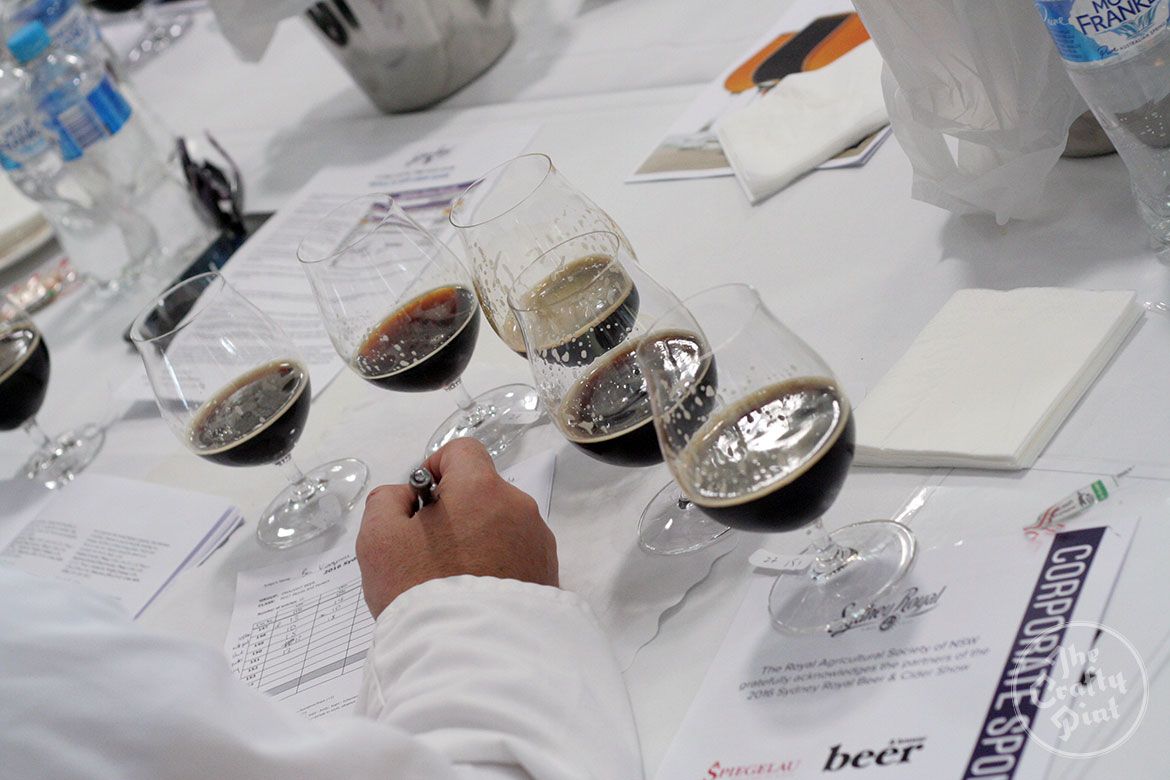
Scoring Points
All beers are judged completely blind. To each glass is attached a randomly numbered sticker to identify the class and entry number, but the only other information judges have about the beer they are about to taste is a few lines of tasting notes supplied by the brewer and a copy of the Brewer’s Association style guidelines for reference.
Unlike many competitions which use a 20 point scoring system, the Sydney Royal uses a 100 point system where judges assess a beer as follows:
- Appearance (15 points)
- Aroma (20 points)
- Flavour (50 points)
- Overall Impression (15 points)
To get a gold medal a beer needs a score of 90 or more, silver is between 82 and 90, and bronze is 74 to 82. Due to the propensity for broader scores within the 100 point system, Sydney Royal has garnered a reputation as being the toughest competition in Australia at which to earn a gold medal. [Incidentally, the judges do like awarding golds but the rigorous system means beers must earn them the hard way. From 2017, Sydney Royal will be changing to a 20 point system in order to make scoring more consistent with other competitions].
While the numbers are the final determinant, from a results perspective it is perhaps less important to dwell on individual points than it is to focus on the standard being applied to each bracket, where a gold represents a world class example of the style, a silver is considered a good example of the style showing technical competence and bronze is a reasonable interpretation of the style with no major faults.
Picking A Winner
It takes around eight hours to get through the several hundred beers at which point, once all the scores have been finalised, the judges and associate judges are free to head to the pub (or, perhaps, home for a cup of tea and a lie down). But, for all the panel chairs and the Chair of Judges, it’s time to sharpen up the senses again for the Championship taste-off, where all the gold medal-winning beers are re-poured and judged again to determine the best beer of the show.
While each beer is measured on its merits, the Championship taste-off is, at its core, a case of comparing apples with oranges; in 2016, the gold medalists were a lager, porter, IPA, scotch ale and imperial stout. A direct comparison of this nature is inherently an imperfect system, but a winner must be chosen – in this case, it was the porter.
A Day In The Life Of A Beer Judge
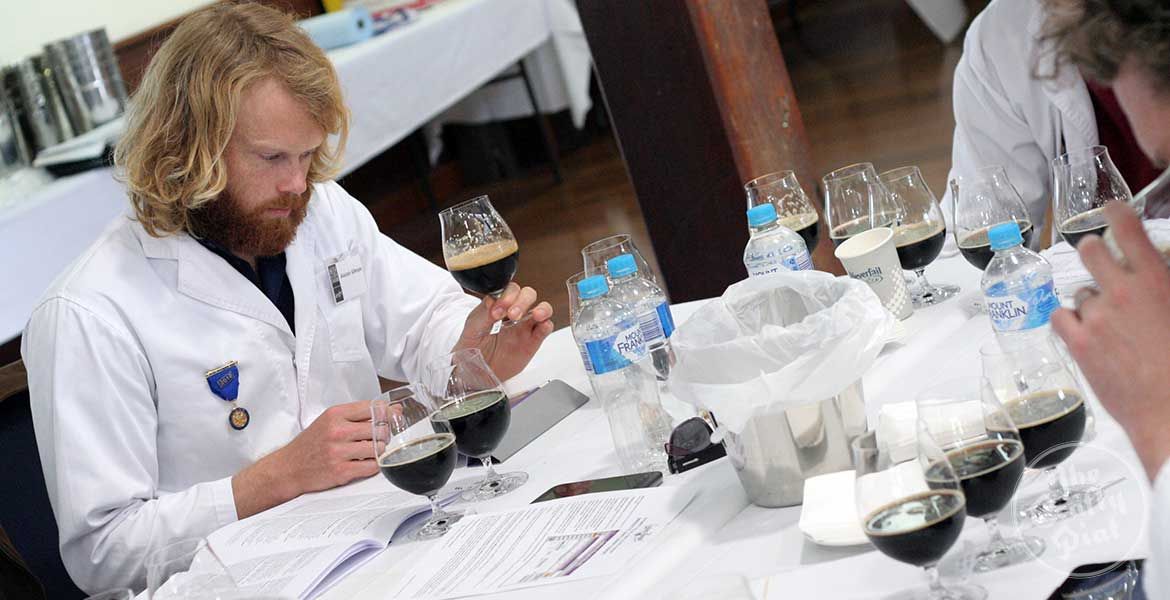
With a general understanding of how a day of beer judging plays out within the wider scheme of the day, it’s time to go inside the head of one of the judges to find out what happens when you're actually sitting in the hot seat with the pressure turned up.
Alastair Gillespie (pictured at top and above) left South Africa and a planned career as a mushroom grower for the sunny climes of Northern New South Wales where, in between breaks to go surfing and fishing, he became head brewer at the rejuvenated Byron Bay Brewery (which, on the face of it, does make a day of beer judging sound like a relatively tough day…).
How long have you been a beer judge, and how did it come about?
I guess I’ve been judging the beers I drink ever since I started making beer about five years ago. Then, in November 2013, I decided to do the Beer Judge Certification Program (BJCP) exam in Cape Town. I’d been brewing at a craft brewery called Devils Peak Brewing Co for about a year and was mostly training my palate through listening to the comments my boss would make whilst drinking beer. He encouraged me to call out any flavours I recognised and to analyse the balance of the beer more critically. The exam went really well and the following year they asked me to host the exam so I had great fun picking out the beers that had to be assessed.
When you’re sat at the table with a line of beers in front of you, what’s the process that gets you to a final score?
The thing I love about judging is how you have no idea about the quality of the beer until you give it a sniff – you have to constantly be completely open to the next beer being an award winner, even if the last one was plagued with off flavours. When I’m working toward my score for the different categories – appearance, aroma, flavour, stylistic accuracy, overall impression – I’m thinking about great beers I’ve had in that category in the past as well as making sure I re-read the style guidelines, which we’re always provided.
Practically speaking, I tend to start off by thinking: “This beer is going to be perfect. Oh no, wait, the finish is a bit astringent, minus some points there” and so on. Then it’s also a case of gauging the rest of the beers in that category, where it’d fare against them and thus how its final score should compare.
A full day of judging involves trying a lot of very different beers. Accounting for palate fatigue, how do you ensure each beer gets judged fairly?
Luckily the events are generally organised so that we judge lighter [flavour and alcohol] beers first and then move onto more intense beers through the day. This really helps because if we started with bourbon barrel-aged imperial stouts before doing light lagers they’d all taste like water.
I also strongly discourage any talking or exclamations at the tables whilst we’re individually assessing the beers. It can really affect your perception of a beer if someone you respect lets out a: “That’s more like it!” or a disgruntled sigh. I also try to drink lots of water and eat my body weight in food.
However, the struggle is real with palate fatigue and, to be honest, I think it’s often the more ballsy beers that stand out from the crowd that do well in contests.
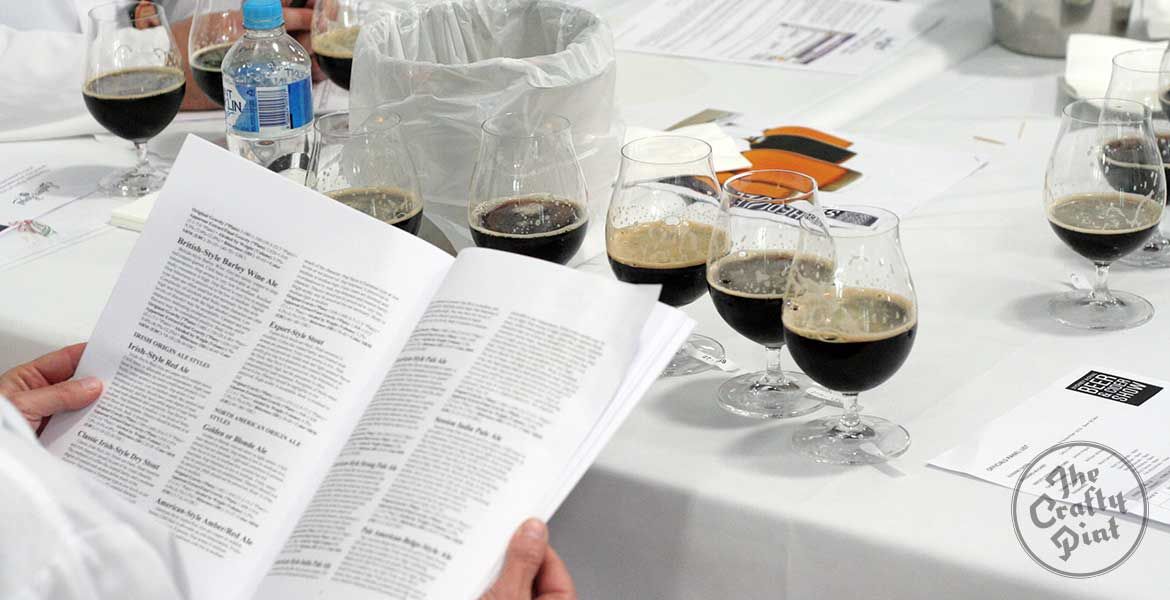
Are there cases when a beer you personally enjoy doesn’t match up with the style guidelines? If so, how do you approach it?
Good question... Yes, all the time!
It’s so tricky and generally before the judging commences it’ll be discussed on how critical to be when beers are not in the correct category. Most people think you judge beer by how much you like it whereas it’s more like you’re seeing whether the beer ticks the boxes of that style. You may get a bright and golden coloured lager with a bold bitterness and some clearly obvious New Zealand hops being entered as a German Pilsner. So you’ll give it good scores for appearance, but as you’re looking for classic European hop characters it’ll fall a little short in the aroma and flavour categories and won’t do too well in Stylistic Accuracy although in Overall Impression you may give it a really high score.
So a great beer may end up scoring in the mid-range if entered into the wrong category. This happens all the time and it’s therefore very important that the entrants take the time to enter the beers into the correct category.
How does a panel of judges come to a consensus in the event that one judge’s score is very different to another?
For example, after individually assessing a flight of about five beers the panel, which consists of about five judges, will discuss their scores and generate a combined final score. Generally the scores will be fairly close but when there’s an outlier we’ll just listen to the reasons why that judge scored it higher or lower. If they can justify their score this could lead to the rest of the panel adjusting their original scores, but otherwise majority rules.

What separates a gold medal winning beer from a silver medal winner?
I think sometimes you’ll know from the first sip whether the beer’s going to be a gold medal winner or not. A gold medal beer should stand out by exhibiting all of the best characters, have absolutely no faults and really exemplify the style – this is a beer you’d tell your friends about. A silver for me is a well made beer with no obvious faults that you’d happily enjoy a few of.
How do you think being a brewer makes you different to judges from a non-brewing (i.e. retail) background?
I think understanding where the flavours of a beer come from really helps in deciding how critical to be when judging that style. It also helps you to give feedback to the entrant as well as help with improving your own brewing and what to look out for or new ideas to trial. After a day of judging I definitely walk out with a couple of new ideas up my sleeve.
To a lot of people judging beer would seem like a dream gig. Is it?
It’s pretty damn good! However, we all take it fairly seriously as sometimes we’ve also entered beers into the competition and are looking forward to the feedback given. To ensure fair play the organisers will make sure your table never gets a beer that you’ve entered.
What’s the best part about being a beer judge?
I feel like I learn so much every time I judge, plus often people you really respect are sitting alongside at the table and you can pick up so much if you remain attentive. You also make some great connections at the post show gatherings and, of course, you get to drink some great beers along the way!
What’s the worst part about being a beer judge?
Having to critically assess infected beers while trying to find something encouraging to include in the feedback.
If someone wanted to become a beer judge, what advice would you give them?
Volunteer as a steward for a beer comp or, even better, get some judging qualifications under your belt. When studying for the BJCP exam, I learnt far more than just defining the various beer styles and also expanded my beer vocabulary.
Personally, I really like the BJCP 2015 Beer Styles app as it’s such a quick reference for the different styles and their history and has thorough descriptions of their flavour profiles. It’s also really helpful to analyse beer with someone experienced and to discuss what you’re each picking up. Getting a flavour taint kit and using it to calibrate your palate can also be an incredibly valuable experience. Most of all, just keep familiarising yourself with all the weird and wonderful styles of beer.
You can read other Day in the Life articles here.
And you can read our past Blind Tasting Panel features here, for which we take a slightly different yet broadly similar approach to the above. We've had an insanely busy start to 2017 so haven't found time to run any Getting Blind With Crafty sessions yet, but they will return, possibly with a public element too...



